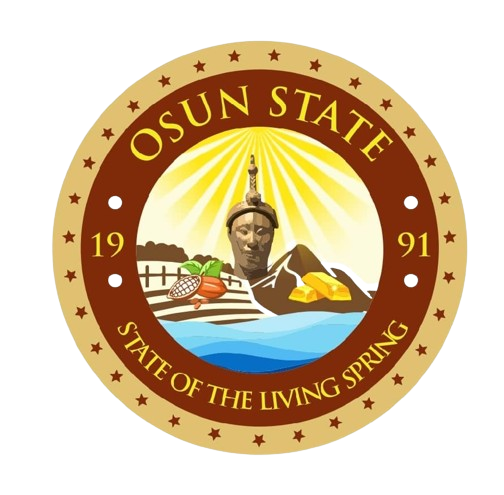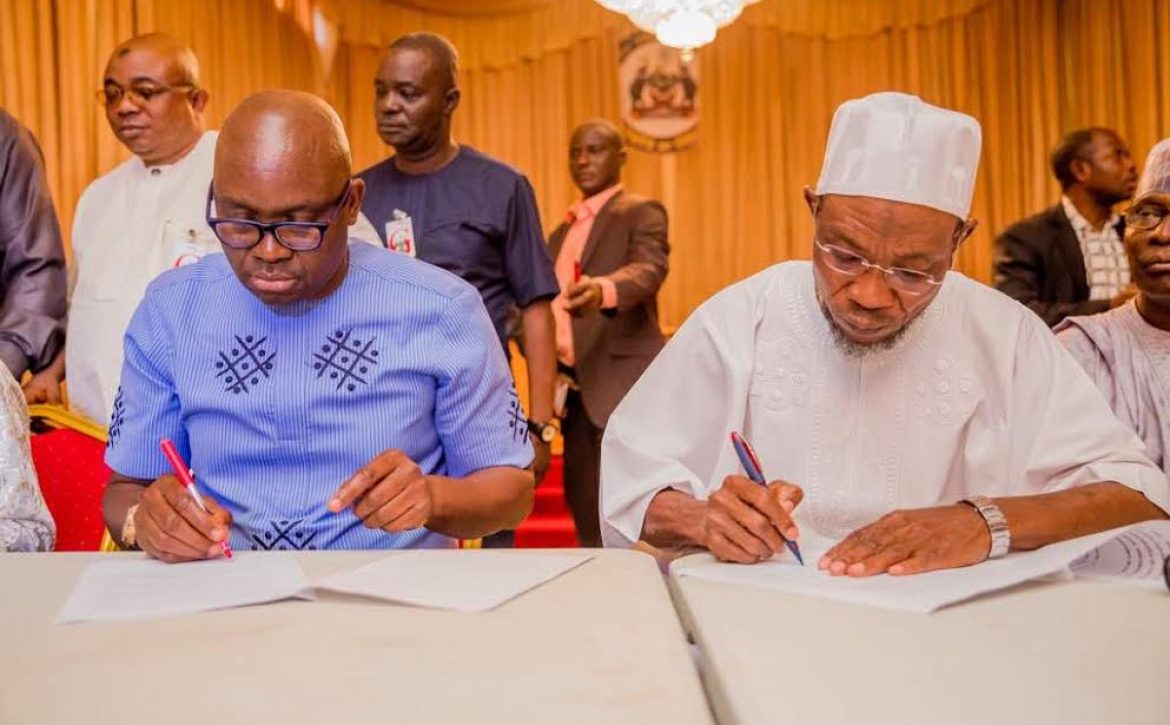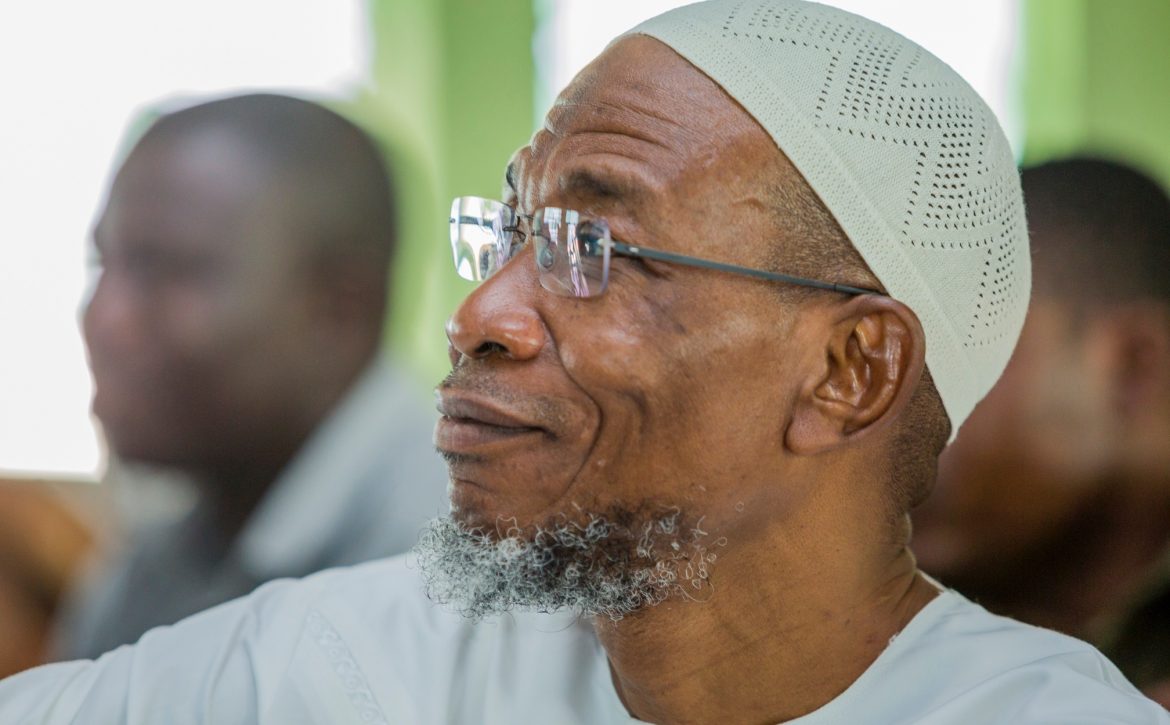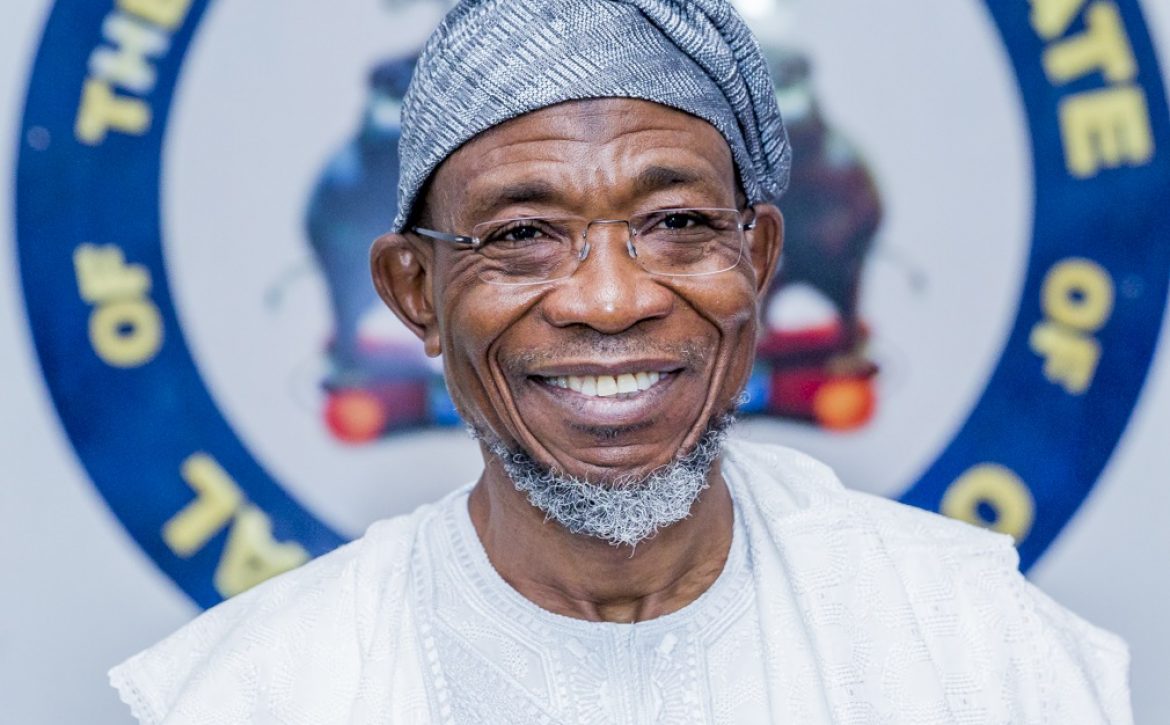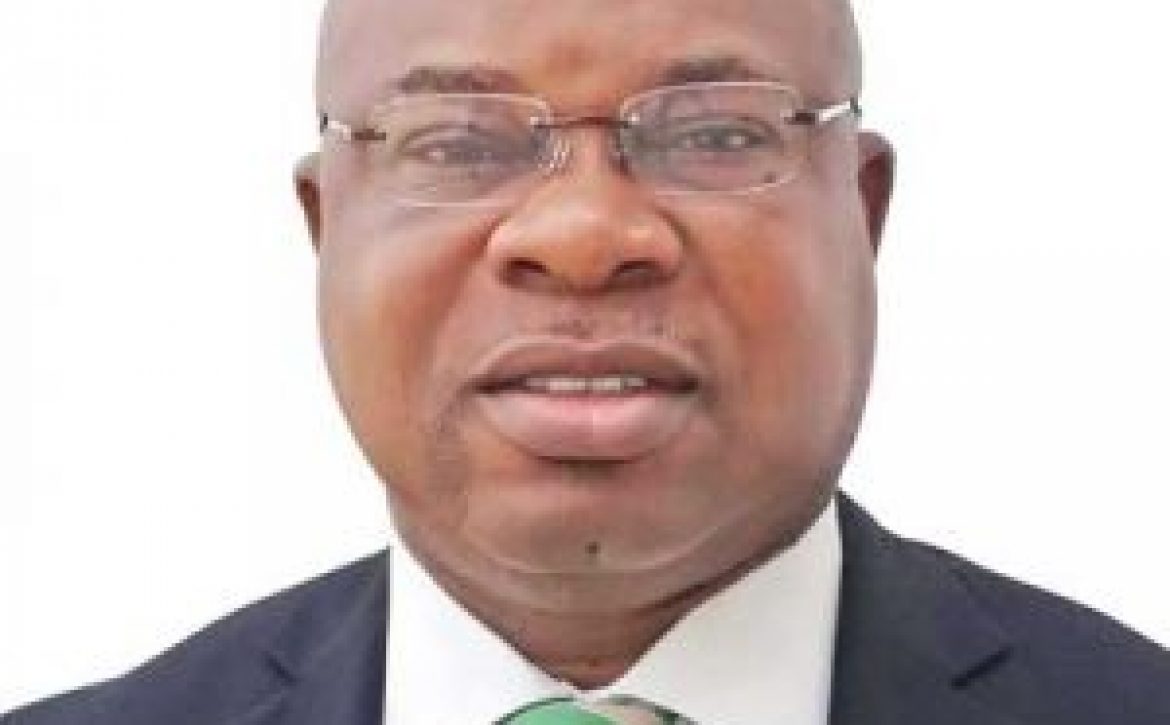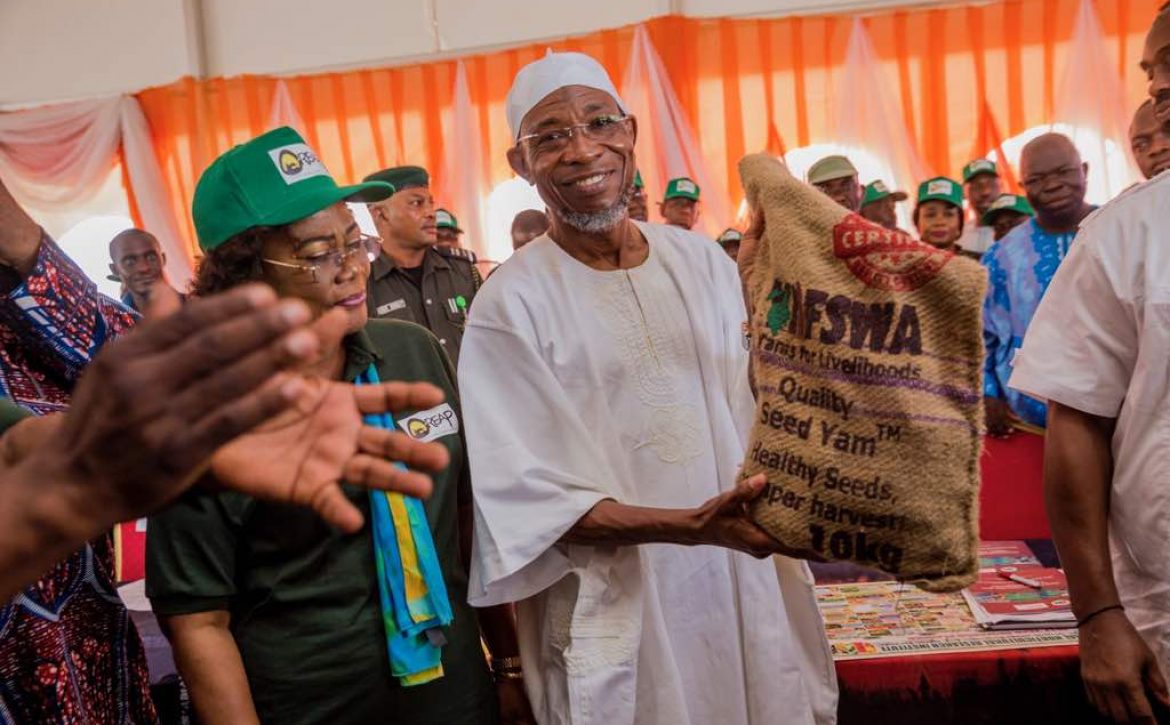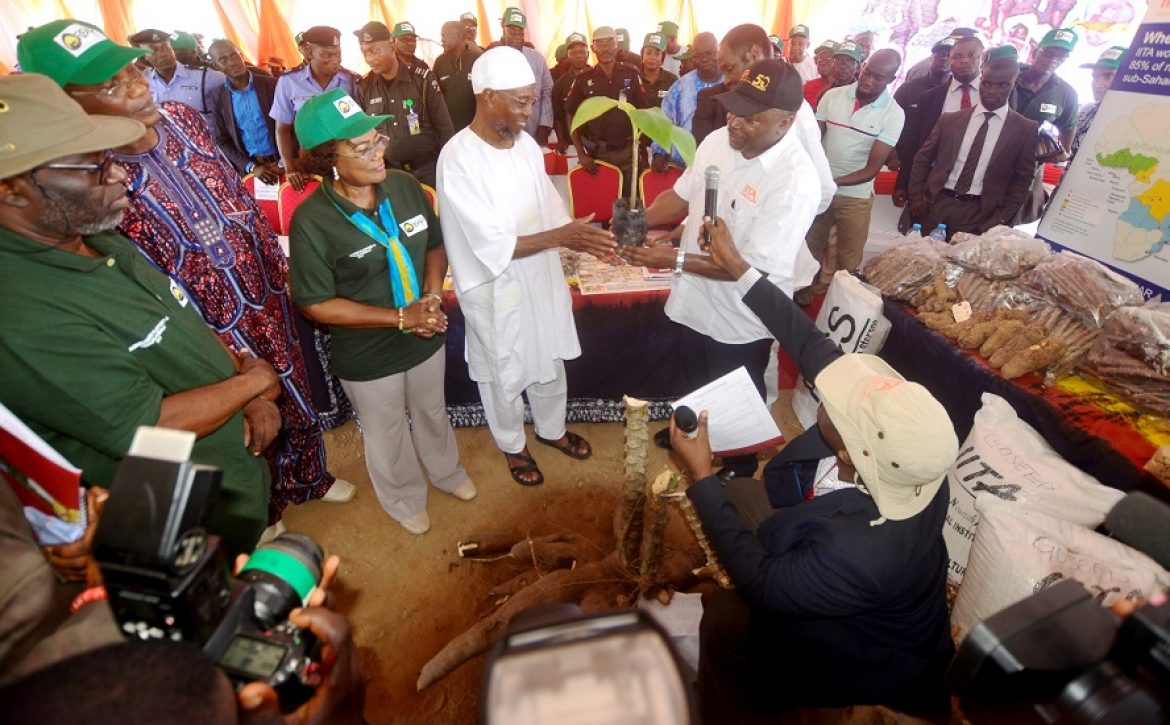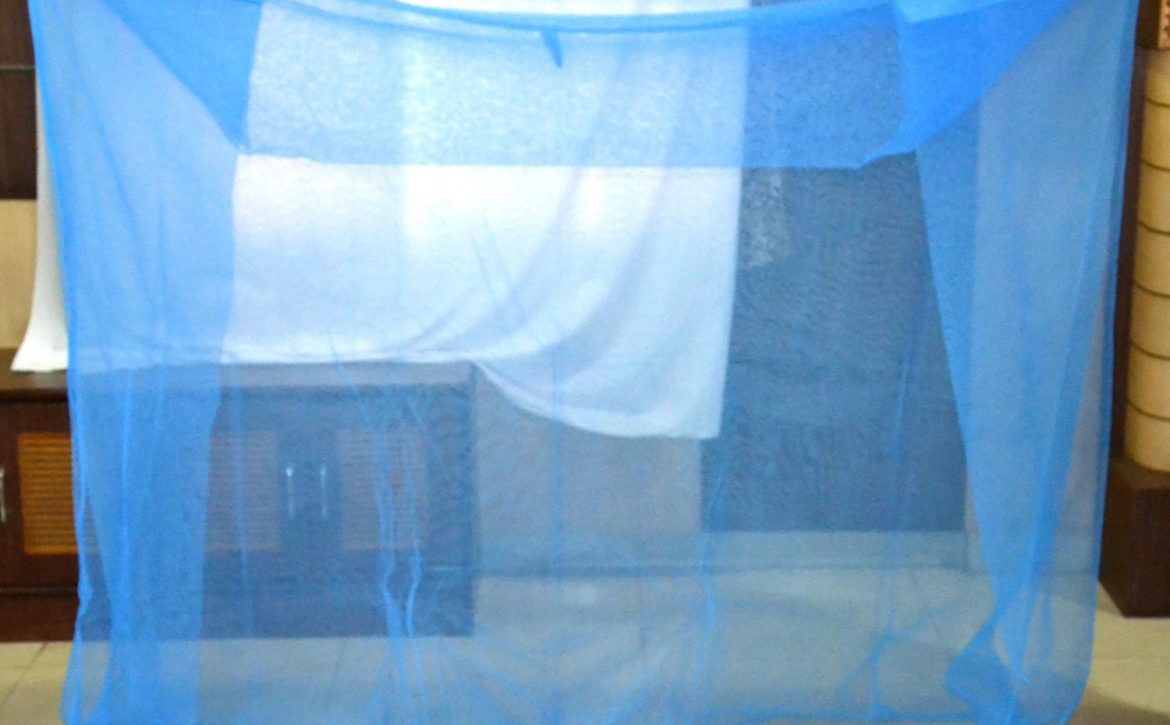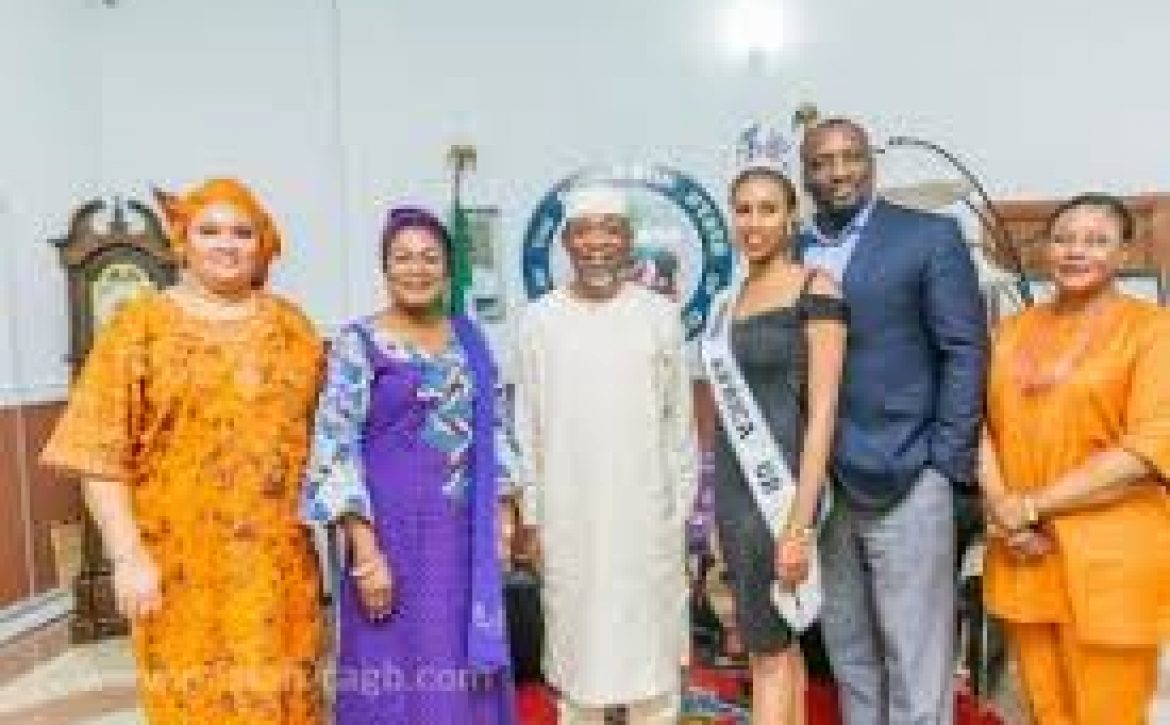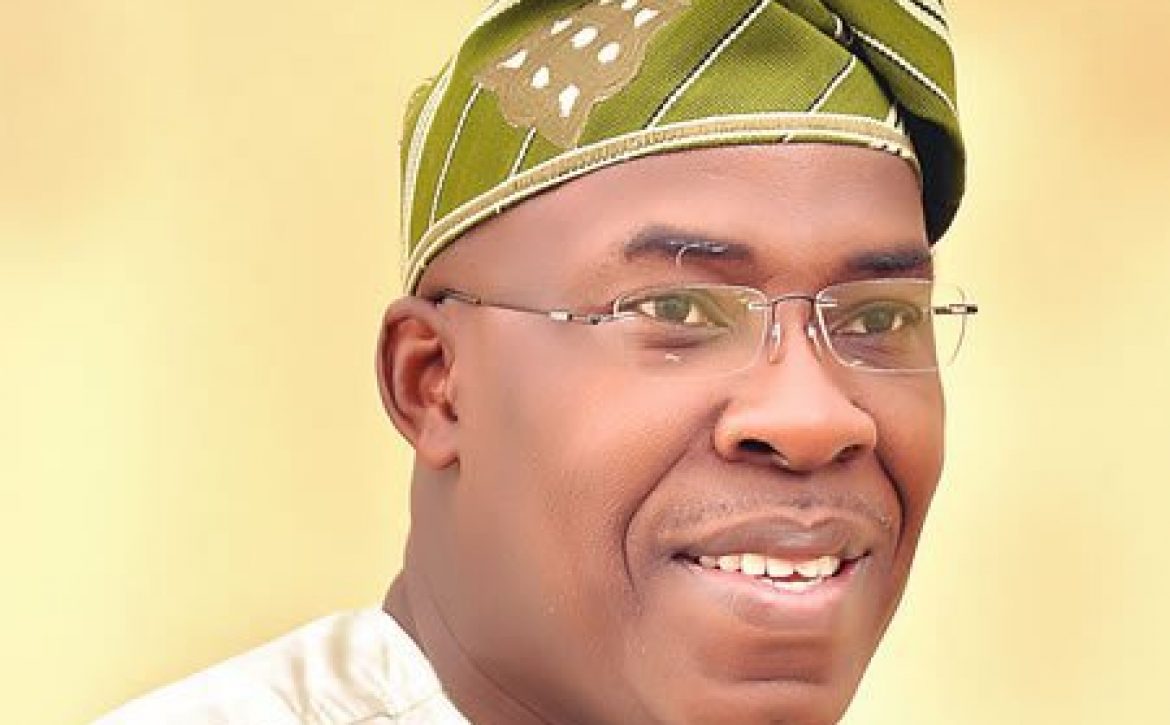The Deputy Inspector General of Police, DIG Foluso Adebanjo, has commended the Governor of Osun, Ogbeni Rauf Aregbesola for his administration’s commitment to the security of lives and property of the citizens and residents of Osun.

Adebanjo, who was accompanied by two Deputy Commissioners of Police in the state for a courtesy call on the Governor at the the Government House in Osogbo commended the efforts of Aregbesola at making the state one of the states with the lowest crime rate in Nigeria.
The visit was part of the DIG’s routine security assessment, evaluation and sensitisation of the officers and men of the State and Zonal Commands of the Nigeria Police Force in the zone on the need to uphold professionalism, efficiency and discipline in the course of duty.
The Police boss also lauded Osun Government for giving the Force necessary support and cooperation in its bid to maintaining laws and order.
Describing Osun as one of the states with lowest crime rate in Nigeria, Adebanjo said the Force has been monitoring the records of the state in the last few years, saying, apart from the atmosphere of peace, the state is witnessing massive development of infrastructure.
He therefore sought for executive support to enhance policing and as well free the state and Nigeria from crime and criminality.
According to him, “Nigeria Police Force is always in support of development. We have seen the developmental strides of Governor Aregbesola’s administration in the state of Osun.
“Let me add to it, Osun has one of the lowest crime rates in Nigeria. We cherish this feat and we know that the tempo would be sustained.
“We have been monitoring events in the state even from Abuja and we know that the state has never relent in its efforts of security consciousness.
“As part of our visit is to appreciate Mr. Governor for being supportive of officers and men of the command just we as we equally commend the good people of Osun for their spirit of cooperation openly demonstrated to Police in the state.
“On our part, we shall continue to live up to expectation of Nigerian people in ensuring a safe atmosphere for all to live. We will not rest on our oars to ensure that our nation is free from crimes of all nature”,.
In his response, Ogbeni Rauf Aregbesola advocated for the decentralisation of Police through a proper restructuring and reform to ensure effective zonal management, control and operation of the Police organisation in Nigeria.
He said Nigeria has grown beyond a centralised policing, saying the devolution of power must be encouraged in the Nigeria Police Force to strengthen the sector for greater productivity.
He said the restructuring of the police and the devolution of its control would go a long way to foster improvement in the system, promoting moral integrity and discipline in the affairs of all police officers and men.
Aregbesola held that, since police remains a civil security organisation, the decentralisation of the system will increase the efficiency and proficiency of the Nigeria Police.
Aregbesola asserted that the complexity and diverse nature of policing in Nigeria has become worrisome, a thing which he said requires urgent restructuring to promote effective zonal and state’s control of its administration and management.
According to him, “The essence of human urbanisation and socialisation is security. Therefore, it is a duty not only for government but also the people to support security agencies especially the police.
“Since the first obligation and responsibility of government remains security and maintenance of law and order, therefore, it behoves on any serious government to prioritise and guarantee the security of lives and property of the citizenry.
“So, there can be civil service or public service without adequate security just as development lies on the security status of any society. All the social and physical infrastructures on any society could be measured by the level of security therein.
“This justifies that there wouldn’t be any iota of development in an unrest, unsecured, volatile and troubled society. And whenever one want any tangible development, thus , one must accord respect and support to security agencies especially the police.
“It is a duty to support the police, and it is in view of this that I strongly clamour for a restructuring of the Nigeria Police to enhance effectiveness and raise the standard of dedication and high sense of commitment to professional ethics, values and conducts.
“It is a misnomer in a society like Nigeria for Commissioner of Police in a state to be directly answerable to Inspector General of Police in spite the fact that there is zonal Assistant Inspector General of Police in the zone to which such state emanates.
“Ideally, CP should be answerable to zonal commander (AIG), while it the duty of AIG to be responsible to IG. This would sanitise the system and instill the spirit of commitment and dedication into the system.
“There is need to federate Police Force. Police must restructure its structure in such a way that would enhance effective zonal structure and management.
“We need to make Zonal Command effective and this can only be achieved through restructuring.
“I am a strong advocate of federalisation of Police Force. We need to devolve the control of Police in such a way that the cumbersome shouldered by the Inspector General of Police would be reduced.
“So, it is high time we go back to drawing board and map out policies that would strengthen high sense of professionalism, effectiveness and proficiency in the Police Force because the unitary structure has become obsolete to a nation like Nigeria”, Aregbesola stressed
Category: Politics
The Governor of Osun, Ogbeni Rauf Aregbesola on Sunday succeeded in breaking the ice of hostilities between his Ekiti State counterpart, Ayo Fayose and oil marketers who had been at loggerheads over the siting of some filling stations in the state.

The Ekiti State Governor commended the swift intervention of the Governor of Osun in resolving the lingering crisis which had led to acute scarcity of oil products in the state.
The truce reached on the intervention of Aregbesola led to the end of the three week old industrial action embarked upon by the Nigeria Union of Petroleum and Natural Gas Workers (NUPENG).
NUPENG suspended the strike with immediate effect.
Fayose, in his remarks shortly after the communique was read and signed by parties involved, said the purpose of coming down to Osun to resolve the matter was to let the world know that the Yoruba nation can take care of its affairs.
He said the existing unity among the Yoruba has got to the extent that issues can be resolved in any part of the region be it Osun, Ekiti, Oyo, Ogun, Ondo and Lagos states.
Fayose said the idea was to further strengthen the existing unity and love among the leadership of the region regardless of political ideology.
According to him, resolving the matter in Osun was a clear demonstration that Yoruba people are one.
“I appreciate Governor Rauf Aregbesola of Osun for this peace process that we have been able to achieve.
“The government and the people of Ekiti state highly appreciate the swift intervention of Osun state government led by Governor Aregbesola.
“This is a manifestation of the spirit of togetherness, love, unity and harmony among the people of this region.
“This is done in the spirit of understanding of Yoruba nation as being demonstrated today that we are one nation and indivisible entity.
“What happened today shows that we have the capacity to resolve issues as states in the region without any external intervention.
“Some people will ask why the Ekiti state government has come to Osun to resolve the matter. But whether is Osun or Ekiti, what is important is that we have resolved the matter and reached a common ground.
“It shows that Yoruba people are one and as well remain indivisible.
“All parties involved have signed a communique and we are going to respect all what is in the communique and we will by the communique just as the committee will be given free hands to work to give a lasting solution to forestall such crisis in the future,” He said.
While reading the communique, the General Secretary, NUPENG Mr. Joseph Ogbebor said the union agreed to suspend the three week strike having reached a common ground with the state government.
Ogbebor reiterated that the two parties have agreed to set up an ad-hoc committee which will after the suspension of the strike oversee the need to find a lasting solution to the crisis.
The communique reads in part: “An ad hoc committee be constituted to fashion out in clear terms the conditions and guidelines for the establishment and operations of filling stations in Ekiti State.
“The committee comprising representatives of Ekiti State Government and oil and gas stakeholders shall commence work on Wednesday 7th June, 2017
“In the spirit of reconciliation, Ekiti State Government agreed to pleas for reversal of the revocation of some Certificates of Occupancy of landed properties on which filling stations are built, except the ones on waterways, canals and where there is no justification for such revocation;
“In that same spirit, the government agreed to stop further demolitions pending the outcome of the committee’s report.
“Consequently, the Nigerian Union of Petroleum and Natural Gas Workers (NUPENG), Independent Petroleum Marketers Association of Nigeria (IPMAN) and other related oil and gas unions hereby suspend the industrial action embarked upon by their members, with immediate effect.
The communique was Signed by: Ekiti State Governor, Dr. Peter Ayodele Fayose, his Osun State counterparts, Ogbeni Rauf Aregbesola,
NUPENG General Secretary, Joseph Ogbebor,
IPMAN Zonal Chairman, Alhaji Debo Ahmed
PTD NUPENG, National Vice Chairman, Comrade Solomon Kilanko
In his remarks, Governor of Osun, Ogbeni Rauf Aregbesola commended the maturity of the leadership of NUPENG and IPMAN exhibited in resolving the crisis between them and the government of Ekiti state.
He expressed profound gratitude and high sense of understanding displayed by the leadership of the Ekiti state oil marketers, saying it has shown that dialogue remains the best method of resolving conflict.
Aregbesola added, “Since this matter has been resolved, I am happy that this brings a permanent peaceful coexistence between the two parties in the state.
“It is believed that this resolution will bring an everlasting and evergreen cordial relationship between and the unions.”
On Thursday, May 25, 2017, family, friends, and well wishers converged on the newly built De-Distinguished Multipurpose Hall in Osogbo for a colloquium to mark the 60th birthday anniversary of Rauf Adesoji Aregbesola, the Governor of the State of Osun. The event, attended by a cross-section of dignitaries from across the state and beyond, could well be regarded as the second Raufnomics in the transformation of Osun.

Raufnomics, coined by Aregbesola’s associates, was launched last year as a shorthand for his profitable use of strategic planning and an innovative economic model to transform the lives of the people of Osun through mass-based and people-centered programmes and projects, especially in education, health care, infrastructural development, youth employment, and social welfare.
Against the backdrop of Osun’s lean profile, when Aregbesola took office in November 2010, and the state’s declining fortunes in the last three years, Raufnomics has turned out to be about using limited resources to guarantee the maximum good for the maximum number of people. This is better appreciated by considering the cumulative impact of all the programmes and projects as a whole, rather than viewing each programme in isolation.
The colloquium, featuring four presentations on Raufnomics, focused on how Aregbesola was able to accomplish his goals: (1) Good governance and challenges of leadership by Mahamoud Abubakar Balarabe (SAN); (2) Democracy and ethics of good governance by Professor Akin Oyebode; (3) Leadership and politics of power struggle by Professor Niyi Akinnaso; and (4) The essence of the transformation agenda of the state of Osun by Dr. Charles Diji Akinola.
As the titles of the presentations suggest, the recurrent themes of the colloquium were leadership; ethics; democracy; and good governance. While Balarabe, Oyebode, and Akinnaso expatiated on one or the other of these themes, Akinola focused on the specifics of Aregbesola’s transformation agenda in Osun during the past six years.
In what follows, I explore, not in any particular order, how these four themes provided the backdrop for Aregbesola’s uncommon achievements. First, Aregbesola gave meaning to our fledgling democracy through his programmes and projects, by involving relevant stakeholders in the distribution of political goods across the state.
His democratic roots date from his student days when he participated in student activism and social movements for the transformation of society. Like the young Fidel Castro, whose political trajectory developed from sympathy for the Black labourers on his father’s sugar cane plantation, Aregbesola has always been drawn to the plight of the masses, especially the downtrodden.
Although an engineer by training, Aregbesola devoured literary pieces, especially African literature, perhaps in his bid to better understand human nature, especially African sensibilities, as he consumed political writings, especially socialist, Marxist, and leftist literature. It was this eclectic literature and his burning desire to transform society that shaped his brand of democracy. It is a liberal, participatory democracy, shaped by elements from various sources, including Mao Tzsetung, Karl Marx, Fidel Castro, and Awolowo. The result is a pragmatic politics, rooted in the people he is appointed or elected to serve.
By the time Aregbesola joined the NADECO fight for democracy, following the truncation of MKO Abiola’s presidential victory in 1993, he had signed up for political struggles that would consume his time for years to come. He would later join the Alliance for Democracy on the return of democracy in 1999 and adopt progressivism as a driving ideology of governance. http://thenewsnigeria.com.ng/wp-admin/post-new.php#
But progressivism did not come to him overnight. Right from his student days until today, Aregbesola never departed from the progressive ideology underlying the programmes of the old trilogy of Action Group, Unity Party of Nigeria, and Social Democratic Party and the contemporary trilogy of Alliance for Democracy, the Action Congress of Nigeria, and now the All Progressives Congress. Aregbesola’s progressivism is in the Awolowo mould of “life more abundant” for all, as evidenced by his programmes in education, health care, agriculture, youth employment, social welfare, and infrastructural development.
Aregbesola is as emphatic in his belief in the rule of law and the importance of debate as drivers of democracy as he is an unapologetic federalist, who believes in the sanctity and relative autonomy of the federating units. He demonstrated this when he led the rejection of the National Assembly’s attempt to encroach on the oversight functions of State Assemblies.
Second, Aregbesola’s achievements are driven by his consistency and loyalty to people and causes. He is a man of uncommon ethical standard, guided by his faith in God, people, and good causes. I have watched him on several occasions agonize over the misrepresentation of his programmes and outright falsification of his intentions. At first, I wondered why a politician should agonize over such behaviours, given the tendency of Nigerian politicians to criminalize political opponents. Upon reflection, I discovered that such behaviours are outside the code of conduct Aregbesola had set for himself.
And what did Aregbesola do that they did not falsify or otherwise run down? They criticized his education reform and school reclassification. The project triumphed. They criticized and lied about the free school uniforms he introduced. The project triumphed. They condemned his school feeding programme, by sidetracking its multiplier economic benefits for farmers, market women, and neighbourhood food vendors as well as its health benefits for school children. The programme became a best seller in the nation, attracting adoption by many other states and even the Federal Government. They also criticized his urban renewal project, despite praises by development experts and part sponsorship by the UN Habitat Programme. They protested the removal of illegal structures in the selected cities as they did school uniforms, but to no avail.
Finally, they said he diverted bailout funds meant for salary payments, because they wondered how projects could continue to be executed in the state in the face of dwindling resources. They failed to unlock the secret behind Aregbesola’s innovative financing options, including flexible financing, and the ability to maintain a strict boundary between funds for recurrent expenditure and funds for capital projects, especially when some of the latter funds were borrowed to accomplish specific projects.
Third, Aregbesola succeeded because his government operated by the major indicators of good governance, including transparency and accountability, rule of law, regulatory control, political stability, and control of corruption. He also delegated authority, using, for example, the Bureau of Social Services as an oversight agency for all kinds of projects in the state.
Moreover, he always ensured that major stakeholders were involved in decision-making, and he would always go back to them for updates. For example, when the state’s financial fortunes began to decline, Aregbesola summoned all labour unions and other stakeholders in the state, and laid bare the state’s financial records. I examined those records at the time, and also met with leaders of the unions. He then set up a committee to oversee the distribution of resources as state allocations were received.
The result was an agreement on structured salary payments, which has sustained the state till today. This effort, of course, did not prevent political opponents from organizing pockets of protests and coopting willing reporters into false reports, even when nearly 30 states were in a similar dilemma.
Fourth, Aregbesola demonstrates the qualities of good leadership, including honesty; confidence; commitment; positive attitude, even in the face of adversity; and faith in his ability to transform the lives of his people. Moreover, he is highly communicative about his goals, policies, and projects.
Above all, he exhumes an inclusive praxis that only a leader could exhume, who is rooted in grassroots politics. I observed this during his re-election campaign in 2014. It was demonstrated again during the colloquium, when every segment of Osun society was represented. Aregbesola painstakingly acknowledged them all, sometimes with the signature song for each group. Everyone has a place in his heart as they do in his programmes and projects.
Has Aregbesola been able to accomplish everything he set out to accomplish? Certainly not. His second term has been hampered by the economic recession which gripped the entire nation. This has opened him up to all sorts of criticisms, including lack of foresight in the allocation of resources. Not even the spread of the economic scourge to at least 30 other states could absolve him of blame by ardent critics.
It is also not the case that Aregbesola has no weaknesses of his own. He is often overenthusiastic and approaches every project he believes in with excessive zeal. While these may well be the weaknesses needed in a leader, who is determined to transform his society, there is no doubt that they are also targets of criticism, and may need to be moderated.
* Akinnaso, a professor of Linguistics and a columnist, was on the panel of discussants during the 60th birthday Colloquim in honour of Governor Rauf Aregbesola of Osun on May 25, 2017
Two major factors influenced my decision to support Rauf Aregbesola, especially, in his reelection bid as governor of the State of Osun in 2014 and I think they are worth repeating here; perhaps they may be helpful to the cause of this piece.

I left Ijebu-Jesa in 1985, after the completion of my secondary school education, but by the time providence would take me back to my Native Nazareth some years later, almost all the roads on the axis had become so impassable that it’d not be out of place to ask if there had ever been a government in place in the state. As good governance would have it, the narrative took a turn for the better less than two years of Aregbesola’s assumption of office. As at last count, government has constructed not less than 1000km of roads and they traverse all the nooks and crannies of the state.
Closely connected to the above was my preference for this fiery and fearless politician at a time it mattered most. Like the story of the elephant and the knife on the day of the former’s date with death, some funny characters whose political antecedents were sufficient enough to qualify them as unworthy candidates for ‘Bola Ige House’ had thrown their hats into the ring in a desperate attempt to capture power from the incumbent governor. Unhelpful also was Nigeria’s political landscape, with its ‘the-more-you-look-the-less-you-see’ features in dubious connivance with the ‘by-any-means-possible’ disposition of its handlers. A third reason for supporting his reelection bid was his integrity. Amongst all the contestants, his integrity stood poles ahead and was clearly non-comparable with his closest rival from the People’s Democratic Party (PDP).
On my part however, I was of the opinion – and, rightly so – that spectatorship was not an option in an event that was designed to shape the future of my state as well as define the destiny of its people. The rest, as it is often said, is history! Of course, these, added to one or two other reasons here and there, have continued to increase the clockwise ticking of the clock of my admiration for the “chattered politician” and I am happy I took such a decision at such a critical time in the life of my state.
Although, democracy has become so acceptable in this part of the world that we now regard service as an established fact, it is important that lovers of good governance use the opportunity that Aregbesola’s birth anniversary presents to briefly reflect on the real definition of service to the people and what the people stand to gain from the presence or absence of it. For instance, why did Aregbesola leave his comfort zone in Lagos where all things were bright and beautiful to become a symbol of resistance to a system that was well-stocked with characteristic fancies and unusual features in Osun? Why did he choose to become a story of courage to a struggling state which, pre-November 27, 2010, was fraught with false starts, painful groping and failing fortunes, indeed a system which wheel of progress was already on its way back to the bottom of the hill?
When, in his essay, ‘The three types of legitimate rule’, Max Weber particularly pointed in the direction of charisma as an essential ingredient a leader must possess if he must succeed, he probably might have had the likes of Aregbesola in mind. But Weber’s option of courage amidst the tragedy and the savagery of primordial sentiments has again brought to the fore the way we are as a state and as a people. A few questions will suffice. Why have professional hoppers who derisively described Aregbesola an uneducated mind so lost memory of historical facts that this gentleman, noted for technical finesse and political astuteness, once had a stint as a teacher at Imesi-Ile High School in the 1970s? Why is this achiever, who has within a short period of six years set the ‘Land of Virtue’ on fire with his dreams, being tagged a ‘debtor-governor’ when, indeed, in the universal space called salary palaver, Osun is just a sample space for other states in Nigeria? Again, why are they equating his vision for Osun with a mission to Islamize the state even as the governor has consistently wondered why trying to be a good Muslim should be misconstrued for ‘conversion campaign’?
Some crooked beings even go as far as referring to him as Bola Tinubu’s ‘Ajele’ (Sole Administrator) in Osun. Agreed, he is! So what? Well, the sad side of our Nigerianness is that there’s nothing one can do to immunize desperate politicians from wallowing in delusional insinuations. Be that as it may, it is a settled premise that Tinubu is a leader whose creative ingenuity and ceaseless potentials unravel by the day. Driven by pure interest and manifest integrity, the Jagaban Borgu is a principled, dependable and caring historian of sort who positively and masterfully replenishes his stock each day through his deeds and actions. It needs to be noted that, despite the “petty envy and outright jealousy by those that feel dwindled by his greatness”, Tinubu is one politician who cannot do any evil beyond his devotion to his political party and commitment to humanity.
In any case, as ‘Ajele’ which the opposition has nicknamed him, Aregbesola is very proud of his relationship with the ‘Governor Emeritus’ of Lagos State, his leader and mentor. Little wonder many refer to him as the ‘Symbol’. On the other hand, in Tinubu’s clan and court, ‘Ogbeni’, as he is fondly called by his admirers, is the ‘numero uno’; but not to the point of being subservient. No doubt about it: Aregbesola is one person whose political judgment Tinubu respects. Essentially therefore, if ‘Ajele’ is a synonym for transformation and rapid development, then, Osun will need several ‘Ajeles’ to bring it at par with the leading states in the federation. Gladly, too, Elisha, the son of Shaphat (1Kings 19: 19-21); Nelson Mandela; Abraham Adesanya; and Bola Ige, evenTinubu, among others, have at one time or another demonstrated that, for one to succeed in life, the ideal thing is to start as an apprentice, a disciple, or a protégé.
An American politician, Benjamin Franklin, once remarked: “human felicity is produced not as much by great pieces of good fortune that seldom happen as by little advantages that occur every day.” One noteworthy reality is that politics is about the economy and economy is about the people. It is about prioritization and allocation of values. Put succinctly, politics is about the people. It is about generational prosperity and usefulness to humanity. Without being immodest, Osun’s developmental strides have presented Aregbesola as a worthy product of Tinubu’s school of politics. An activist whose primary concern is how to build a super system, not super human, Aregbesola has happily and healthily given pleasure to others by ‘rambunctiously’ spearheading the technological transformation of Osun into “a developed, cleaner, safer and more beautiful state”. The man behind the ‘O’ Revolution in Osun is an outstanding politician of authority who has by his pursuit of causes with unblemished peculiarities shut the mouths of enchanters whose remit is in sounding like broken bottles for reasons not unconnected with selfish ambitions and personal gains.
Mention his accomplishments! Is it in the education sector where, as at last count, a total of 55 new structures, comprising 20 Elementary, 22 Middle, and 13 High School have been added to existing structures while a total of 82 school blocks, comprising 1,534 classrooms across the state have been refurbished by his administration? Or the Elementary School Feeding Scheme, (O’MEALS) which has also greatly reduced unemployment by absorbing no fewer than 20,000 food vendors, in addition to providing certain categories of pupils with highly nutritious meals on a daily basis? Or the Osun Youth Empowerment Scheme (OYES) which, with its mopping up of more than 40,000 youths off our streets and productively engaging them, has succeeded in reducing the scourge of unemployment among our youths? Have we forgotten the creation of additional 31 Local Council Development Areas (LCDAs), 3 Area Councils and two Administrative Offices for the overall purpose of bringing government closer to the people? Or the procurement of 25 Armoured Personnel Carriers (APC) and 100 Patrol Vehicles which has greatly helped in making Osun “the safest state in Nigeria”? Of course, the list is endless!
Aregbesola’s intervention in the hospitality sector has also not gone unnoticed. For instance, Osun now has more than 400 hotels, out of which more than 15 are in ‘Category A’ (equivalent to a ‘3-star’ hotel). Before this administration came on board, the state could only boast of less than half of this figure. Added to these are more than 80 Tourist Attractions in the state. The establishment of Osun Microcredit Agency has also gone a long way in reducing unemployment as well as alleviating poverty in the state. Taken together, these laudable initiatives have helped a great deal in shoring up the state’s internal revenue base, particularly, at a time Nigeria is painfully hemorrhaging from dwindling economic fortunes as a result of global oil glut.
According to Woodrow Wilson, “a man has come to himself only when he has found the best that is in him, and has satisfied his heart with the highest achievement he is fit for.” So, which is easier to say: ‘Aregbesola has no money in any bank anywhere in the world’, or to say: ‘he has not drawn salary since he became governor of the State of Osun’? Or that he has only two buildings: one in Egbeda, Lagos; and the other one in Ikeja-Lagos, given to him as ‘retirement benefit’ by Lagos State Government for serving as its Commissioner for Works and Infrastructure between 1999 and 2007? Of course, this is where plunderers who latch on the rebellious twists and turns of seeming adversity or perceived inadequacy of the moment to judge Aregbesola’s government are missing it. Today, we discuss Obafemi Awolowo in glowing terms, not because of the money he stashed in any local or foreign bank; or the number of houses he built. Rather, it’s because of his transparent commitment to the development of Yorubaland in particular and Nigeria in general.
As ‘Ogbeni’ floats through the years ahead with grace and good cheer, may principalities and powers, assigned to rubbish our leader’s efforts, scatter!
*KOMOLAFE writes in from Ijebu-Jesa, Osun State, Nigeria (ijebujesa@yahoo.co.uk)
The newly sworn in Commissioner for Finance ,Mr Bola Oyemaji has charged the entire staff of the Ministry of Finance to be up and doing in their duties to get optimum results.

Mr Oyebamiji made the charge while meeting the Management of the Ministry on assumption of office .
The Honourable Commissioner seeks for support and collaboration of staff with a view of moving the State forward.
He also promised to operate open administration while encouraging staff to be committed , hardworking and prayerful.
He then urged the staff to cultivate the habit of team work, love , tolerance, friendliness and uprightness in their duties. He said by doing this, optimum results would be achieved.
In her response, the Permanent Secretary, Mrs Adebimpe Ogunlumade while welcoming him assured him of unalloyed support and cooperation of the staff to achieve a greater height.
The Governor of Osun, Ogbeni Rauf Aregbesola on Thursday launched a research and training farm institute at Ago Owu area in Ayedaade Local Government Area of the state as part of his administration’s commitment to transform agriculture sector in the state.
The Research Institute, according to Governor Aregbesola was achieved in collaboration with the International Institute of Tropical Agriculture (IITA).
Aregbesola disclosed that the state had released 205.5 hectares of land for the take-off of the programme as part of efforts to advance agriculture in the state.
While launching the institute at Ago-Owu Farm Settlement, Governor Aregbesola attributed the success of the scheme to unflinching support which the state received from the officials of the IITA to boost agricultural productions.
See photos below:





The Governor of Osun, Ogbeni Rauf Aregbesola on Thursday launched a research and training farm institute at Ago Owu area in Ayedaade Local Government Area of the state as part of his administration’s commitment to transform agriculture sector in the state.

The Research Institute, according to Governor Aregbesola was achieved in collaboration with the International Institute of Tropical Agriculture (IITA).
Aregbesola disclosed that the state had released 205.5 hectares of land for the take-off of the programme as part of efforts to advance agriculture in the state.
While launching the institute at Ago-Owu Farm Settlement, Governor Aregbesola attributed the success of the scheme to unflinching support which the state received from the officials of the IITA to boost agricultural productions.
Governor Aregbesola who described the institute as a “citadel of knowledge in agriculture” said with establishment, all challenges confronting farming and farmers would be put behind.
He said the institution has the capacity to train, retrain and conduct various researches that would not only increase farmers’ yields but also expose them to modern agriculture practices.
Governor Aregbesola said the idea was nurtured in a bid to support the existing farmers and encourage young ones into farming, saying with the scheme, a new era has begun in the agriculture sector in the state.
Aregbesola said the scheme was part of his administration’s six-point integral action plan to increase on the agricultural produce, improve the welfare of farmers and turn Osun to food basket of the southwest Nigeria.
According to him, the idea behind the establishment of the institute is to advance research in agriculture sector in line with the state’s commitment to agribusiness and commercialisation.
“We must thank the IITA for the partnership we have because with the establishment of this training institute, our partnership is not just a memorandum on paper but rather a memorandum actualised.
“IITA has been an open partner with Osun government and the partnership was formalised in 2015 after a Memorandum of Understanding was mutually signed to support agriculture sector in the state.
“This MoU has been actualised with the research and training institute set up to advance research in agriculture, encourage participation in farming and as well improve on the agricultural productivity in the state.
“This initiative aimed at improving on the agricultural agenda of the state, getting youths attracted to farming, exposing farmers to modern and mechanised farming techniques and as well increase agricultural productivity”, he added.
On why the state decided to partner IITA, Aregbesola said the decision was taken having realised the agricultural poor yielding culture in the state.
According to him, Osun is the highest producer of cassava in Nigeria but even as that, the state produces just 16 metric tons per hectare which is far from expectation.
He added, “We partner this international institute to deepen our commitment to massive food production in the state and ensure that the farmers’ yields are improved geometrically.
“For instance, Osun is known to be the highest producer of cassava, but with this feat, our production is poor while the yield per hectare is between 15/16 metric ton per hectare.
“This is widely far from reality while compare with what those who have advanced on the production of cassava have per hectare, and it is for this reason that reached a compromise with IITA to support our farmers for greater productivity.
“As I am speaking now, what we produce as far as cassava production is concerned has increased tremendously as it has increased from 16 metric tons per hectare to 40 metric tons per hectare.
“It is our belief that with this partnership, Osun farmers most especially the existing ones would begin to experience a new life in the agriculture sector while youth would also be encouraged to farming.
“With this partnership, no farmer would suffer anything as far as farming is concerned because this initiative would go a long way to support all there needs and bring a difference into the system.
Earlier, the Deputy Director General, International Institute of Tropical Agriculture, IITA, Professor Michael Abberton, said IITA partnered Osun government having realised the keen interest of the state to revamp agriculture sector.
He described the state’s commitment to agriculture revolution as remarkable, a step he said would be advanced by the IITA to ensure the actualisation of the state dreams in the agriculture sector.
Prof. Abberton who spoke on behalf of IITA, said the partnership was important as it reflects the role the farm will play not only in terms of research addressing the needs of smallholder farmers but also in terms of training and capacity building.
He said the MoU signed between the state of Osun and IITA in 2015 was the consolidation of long tradition of formal partnerships with various stakeholders around the state which according to him represents IITAs commitment to build on this tradition and to further enhance the transfer and adoption of IITA research to the benefit of the farmers in the state.
” I welcome you all and thank those involved in organising this event and in the setting up and developments of this IITA Research and Training Farm.
“This is important as it reflects the role that this farm will play not only in terms of research addressing the needs of smallholder farmers but also in terms of training and capacity building.
“In particular the IITA Youth Agripreneurs will be making good use of this farm in the development of their activities.
“IITA has had a long tradition of training, transferring technology to farmers in the State of Osun, through various projects. The MoU signed between the state of Osun and IITA in 2014 was the consolidation of long tradition of formal partnerships with various stakeholders around the state.
“This farm represents IITAs commitment to build on this tradition and to further enhance the transfer and adoption of IITA research to the benefit of the farmers of Osun state.
In his welcome address, the Director General, Office of Economic Development and Partnerships and Coordinator, Osun Rural Entreprise and Agriculture Programme, Dr. Charles Akinola, said the initiative was to bring technology closer to the farmers in all aspects of agricultural production.
According to him, we are doing this to have huge production yields. It is hoped that with this, Osun farmers will begin to count gains as agriculture would be commercialised while our state would become training centre for her peers in agriculture sector.
“Youths would also be attracted to farming since this partnership would provide the necessary seeds with early maturity.
“We want to make agriculture a way of life and a real business for all and sundry”, he stressed.
While presenting the agriculture inputs to state government, the Project Leader, Cassava Weed Management and Director, development and Delivery Office, IITA, Dr. Alfred Dixon, assured the state of the organisation’s readiness to ensure that the state have highest tons and yields in all areas of agriculture.
“We are here to work with Osun government to ensure that its agricultural policies are achieved.
“Our objective is to ensure additional values in all areas of agriculture. We have come with lots of seeds. We have many farm materials and we ensure that youths in the state are encouraged to farm.
“With what we have on ground in terms of agriculture materials coupled with our expectation on yield, Osun can export farm produce to 17 states”, he added.
The Permanent Secretary, Ministry of Health , Dr. Akinyinka Oluseyi Esho has assured the Long lasting insecticide Nets Team Leader (LLINs) , Mr. Olumide Adefioye of Maximum Cooperation in the distribution of mosquito Nets given to the State of Osun.

Dr.Esho gave the assurance today at the inauguration meeting held in the Ministry of Health.
According to him, the government will contribute its quota to the success of the exercise because quality health care service is one of the strong pillars of this present administration under the leadership of Governor Rauf Aregbesola.
Speaking earlier, Mr. Olumide Adefioye, the team leader from Abuja Federal Ministry of Health said one million LLINs have arrived the State of Osun in preparation for the distribution of insecticidal net to every household in the state.
Others present were representatives from Ministry of Information, Education, Women Affairs, Environment, religious leaders and Market women.
The reigning Miss Africa Great Britain, Miss Sarah Jegede has described the Osun education system as one of the best in the world.

She rated the huge investment made by the Osun government in education sector as most impactful, most beneficial and most adaptable in Africa and beyond.
In a statement by the Bureau of Communication and Strategy, Miss Jegede was quoted as stating this when spoke at the Osun State Broadcasting Corporation (OSBC) where she attended the tree planting program in honour of the Governor.
In the statement signed by the Director, Semiu Okanlawon, Jegede said her account was formed after a critical assessment of tremendous achievements recorded by the Osun government in education system.
Miss Africa Great Britain, who was on a charity tour to Nigeria and Osun state in particular, said Osun government has built a better future for the people of the state through its intervention in the education sector.
Describing education as the bedrock of societal growth and development, Jegede said the state had laid a solid foundation for socio-economic and political lives of her citizenry.
She said with landmark achievements in the education sector, brighter future awaits the state in other sectors of the economy since education and knowledge determine how future of the society would be.
Miss Africa averred that the government of Osun has taken education beyond African affairs with the provision of state-of-the-art facilities that could only be found in advanced countries, at all levels of education in the state.
Commending Governor Rauf Aregbesola for building a virile future for his people, through the provision of quality education, Jegede said Osun has made an edge ahead of others in the education sector.
According to her, it is absolutely rare to see an African leader that would be so passionate for education as case of Osun state.
“Every year, the reigning Miss Africa Great Britain carries out some charity projects across the globe most especially Africa. And as a reigning Miss Africa, I am in Nigeria to accomplish this aim.
“So, I am in Osun state of Nigeria, the state that is accidentally my own to perform the assignment.
“But since a week that I have been in Osun, I have been experiencing the impact of what could be best described as good governance and impactful leadership.
“I have heard good remarks about Mr. Governor. Everybody loves him for what he has been doing to raise the bar of governance, setting out agenda to transform the economy of the state and lots more.
“Yesterday I went to some public schools in the state where I did my charity project. I distributed some educational materials, stationery and school bags to pupils and students as part of what I came to Nigeria to do.
“But some of the things I noticed was the unique appearance of these pupils who were in conformity in uniforms and who were given free meals provided by the state government on every school day.
“I was overwhelmed with this initiative because since I have been on earth I have never seen government embarks on such pro-people social support programme which was aimed to develop education.
“I was very amazed and glad to see beautiful model schools built by the state in most serene environment that is highly supportive to teaching and learning process.
“I have been to the three categories of the state education system. I have been to the Elementary, Middle and High schools and I was highly impressed not only with the structure but with the facilities therein.
“These are the beautiful schools, probably the best looking schools I have ever seen in my own time since I have been in Nigeria.
“This would in no small measure help to reawaken education system from slumber and as well prepare the citizens of the state for greater future Osun as we have in advanced countries.
“The government gesture on this, is applaudable, rewarding and remarkable as it has the potential of taking the state to most enviable position,” she stressed.
Omoba Dotun Babayemi, a chieftain of the All Progressives Congress (APC) in this interview with The Independent Newspaper shares his thoughts on development in Osun and other issues. Excerpts:
You were recently honoured with Evergreen Award for Humanitarian Services by the Osun state chapter of the Nigerian Union of Journalists (NUJ). What is your perception about the award?

I am very grateful and I dedicated the award to Almighty God, my family and especially my constituency. Being recognised for humanitarian deeds is probably the most fulfilling thing. As a private citizen, I have done my bit in ensuring that the quality of life of people around us is improved. The award has brought me to a point where I am now encouraged to do more because having the fourth estate of the realm recognise you because of your contributions in the society makes it a lot more special. So, I am very much encouraged to do a lot more.
As a successful businessman, why have you decided to join politics which many people will describe as dirty?
If you look at some of the people that have come before us, someone like the great sage, Chief Obafemi Awolowo. He was a successful practitioner, yet he gave that up in order to serve his people. Look at our leaders like General Alani Akinrinade who lost everything in the fight to ensure that Nigeria remains one. We also have other leaders like the late Anthony Enahoro, Papa Bisi Akande and even the governor of the stateof Osun, Rauf Aregbesola. He was a successful businessman but he gave that all in service. I believe there is nothing as fulfilling and satisfying as being able to better the lot of the people in the environment. That to me is what politics is all about.
How will you assess the performance of Governor Rauf Aregbesola in the last six years?
Ogbeni Rauf Aregbesola over the last six years has been one of the most outstanding leaders we have had, not only in the Yoruba nation but Nigeria in general. When he came into power in 2010, within 90 days, he took 10,000 youths off the street through the O-YES programme.
He was the first person to do that till date. His challenge has always been focused on the people. Osun state was one of the first states to implement the minimum wage that was put forward at that time and it has a huge impact on him but through reasonable financial reengineering, he has been able to manage that aspect responsibly. We’ve had some challenges as a country.
For example, the FAAC allocation that comes to Osun is now a minuscule bit of what it used to be. Yet, if you go to the state of Osun today and you compare it to what it was at inception, and you look at every government that has been in place, the changes that we’ve had in that state since Governor Aregbesola beats everything else that was before it. Some of the challenges that people has is that they want everything now. The question they ask is ‘ what can I get into my pocket’?; forgetting that as a leader, you must have the vision that encapsulates not just the benefit of people of today but of the people of tomorrow.
When you assess his government in the area of infrastructure, based on the funds available, he is probably heads and shoulders above any other government in Nigeria today. If you go to the local government, there is no area in Osun today that you will not find an edifice that is encouraging not just to the populace but it is an incentive for the kids to want to go to school. It is an incentive for the parents to say this where my children are being trained. He is not just doing it for today but for generations yet to come. In terms of people-centric policies that he has put into place, I will score him 100 percent.
Osun introduced the school feeding programme which the FG has now copied. The number of children in Primaries 1-4 which were here before Aregbesola came in tripled when this were brought into place. Can you imagine what will happen if we are able to replicate this in all parts of Nigeria? That is investing in the future. If you go to the First Republic, the South Western part of Nigeria got independence before anybody else because of innovative programmes such as free education, infrastructural developments and so on. We had the first radio and television station in Nigeria at that time in Ibadan.
Liberty stadium in Ibadan was the first. If you look at the way Aregbesola is running his government, there are many firsts that is being replicated. History is judging Awolowo now for being a trailblazer. I am positive that posterity will also judge Aregbesola for good.

